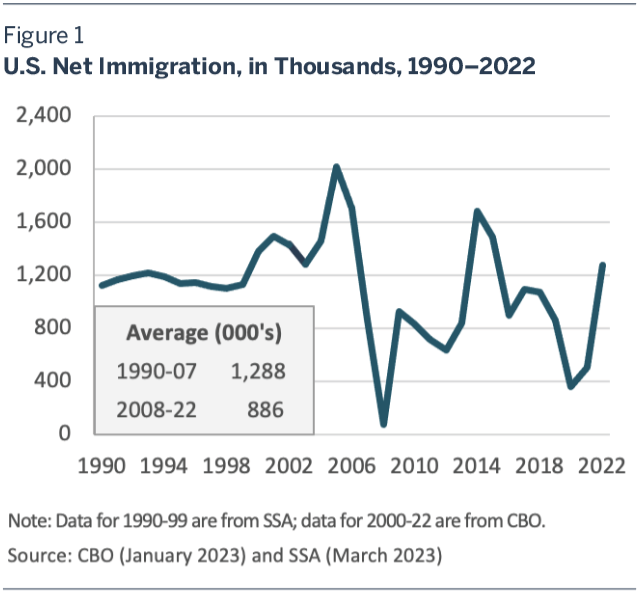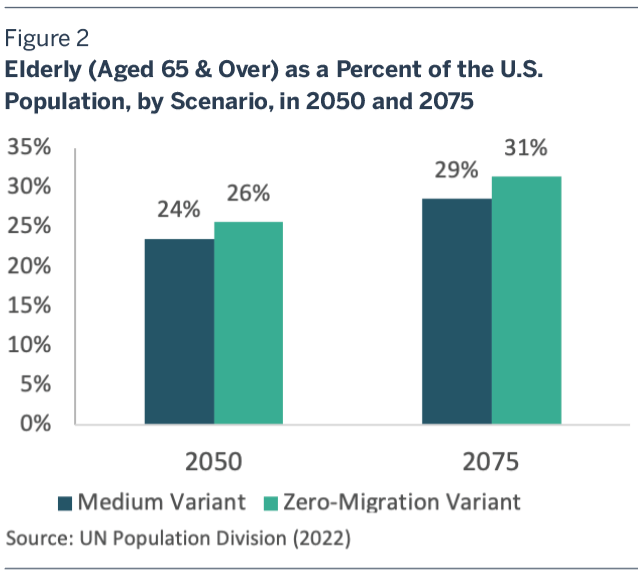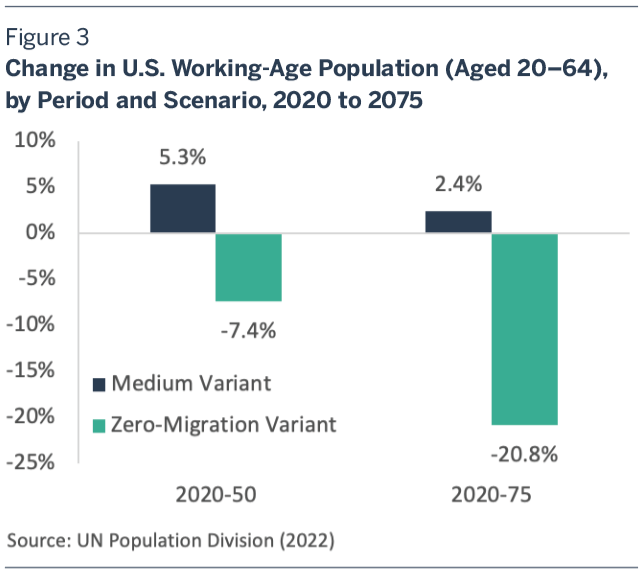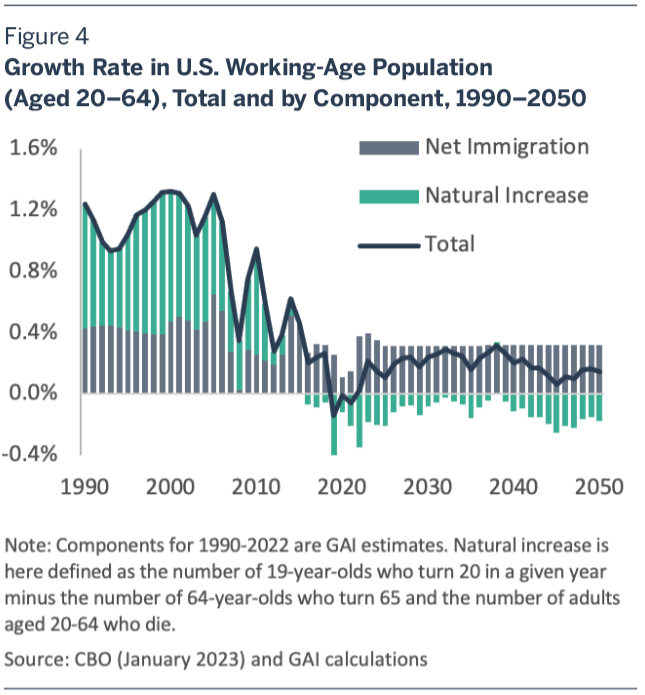Why an Aging America Needs Immigration
Vantage Point: Mini Briefs from The Terry Group and the Global Aging Institute
May 31, 2023

Immigration is already the only reason that the United States still has a growing workforce, and by the 2040s it will be the only reason that it still has a growing population. In this issue of Vantage Point, we take a step back from today’s politically polarized immigration debate and consider the critical role that immigration can and should play in an aging America.
Immigration has been much in the news lately. There is the surge in asylum seekers at the southern border, the bussing of migrants to “sanctuary cities,” and the expiration of Title 42, an emergency measure that allowed the immediate expulsion of migrants on public health grounds. Then there are the controversies over broader policy issues that never seem to be resolved, from how (or whether) to curb unauthorized immigration to how (or whether) to offer a path to citizenship to unauthorized migrants who already live here.
What’s missing in all of this is any sense of the bigger picture. You would never know from the current debate that net immigration has actually declined substantially since the Great Recession. Nor would you know that, even as net immigration has declined, its importance to demographic and economic growth has been increasing. Immigration is already the only reason that the United States still has a growing workforce, and by the 2040s it will be the only reason that it still has a growing population.
In this issue of Vantage Point, we take a step back from today’s politically polarized immigration debate and consider the critical role that immigration can and should play in an aging America.
Recent Demographic Trends
Let’s start with a brief review of recent demographic trends. Until the Great Recession, the United States was a demographic outlier among its developed world peers. Its fertility rate hovered between 2.0 and 2.1, far above the OECD average and close to the replacement level needed to maintain a stable population from one generation to the next. Together with substantial net immigration, America’s unusually high fertility rate seemed to ensure that it would remain the youngest of the major developed countries for the foreseeable future. It also seemed to ensure that it would still have a growing workforce, even as those in other developed countries stagnated or contracted.
All of that has changed. The U.S. fertility rate has declined steeply since 2008. As of 2021, the latest year for which complete data are available, it stood at 1.66, just a shade above the OECD average. Meanwhile, net immigration—that is, the number of migrants minus the number of emigrants—has also declined. Unlike fertility, whose decline has been more or less linear, immigration has followed a roller-coaster path, with huge peaks and valleys. (See figure 1.) The trend, however, has been downward, from an average of 1.3 million per year from 1990 to 2007 to 0.9 million per year since then.
Unless these developments are reversed, the United States will age considerably more than most demographers thought likely just a decade ago. As we explained in a previous issue of Vantage Point (“Is America’s Baby Bust Over?,” June 29, 2022), the prospects for a recovery in the fertility rate are at best uncertain. Immigration has thus become all the more important to future growth and prosperity.
Large Economic Benefits
To be clear, immigration cannot reverse the aging of America’s population or solve all of the economic and fiscal challenges it poses. Because migrants tend to be younger on average than the native-born population, higher immigration can temporarily slow the pace of population aging. But migrants eventually grow old in their turn, which means that unless an increase in immigration is both large and rising over time, it cannot greatly alter the long-term age structure of the population.
A good way to illustrate this point is to compare the UN Population Division’s medium variant projection for the United States, which assumes net immigration of 1.0 million per year, just above the post-Great Recession average, with its zero-migration variant, which, as its name suggests, assumes there will be no net immigration in the future. With immigration, the UN projects that the elderly share of the U.S. population will grow to 24 percent in 2050, while without immigration it would grow to 26 percent. By 2075, the corresponding figures will be 29 and 31 percent. (See figure 2.) Immigration helps here, but only marginally.
Where immigration makes a critical difference is in increasing the growth rate in the working-age population, and hence the growth rate in employment and GDP. Once again, consider the two UN projection scenarios. In its medium variant, the UN projects that the U.S. working-age population will grow by 5.3 percent between 2020 and 2050, while in its zero-migration variant it projects that it will shrink by 7.4 percent. The advantage of immigration, moreover, continues to compound over time. By 2075, the working-age population will have grown by 2.4 percent with immigration but shrunk by 20.8 percent without it. (See figure 3.) To look at the numbers another way, by 2075 the working-age population would be nearly one-third larger with immigration than without it. All other things being equal, GDP would also be nearly one-third larger—and a larger GDP in turn makes all things more affordable, including paying for the cost of our aging society.
In addition to increasing employment growth, many economists believe that immigration also increases productivity growth, giving an extra boost to GDP. For one thing, a faster growing workforce increases the need for capital-broadening investment, and higher rates of investment and a more rapid turnover in the capital stock can spur technological progress by increasing opportunities for “learning by doing.” For another, numerous studies have found that the entrepreneurial initiative and greater diversity of skills that migrants bring to the economy can also spur productivity growth. Indeed, the boost that immigration gives to GDP by increasing productivity may be as important as the boost it gives by increasing employment.1
In short, while immigration cannot reverse the aging of America’s population, it has large economic benefits which can help to ensure that an aging America is still a prosperous America.
Misplaced Concerns
Although the advantages of immigration are widely recognized by economists, a number of largely misplaced concerns about its costs and benefits continue to distort the policy debate.
Perhaps the most frequently heard concern is that migrants take jobs from native-born workers. This is of course possible at the firm level, and may even be possible at the industry level. But at the economywide level the concern is groundless. Jobs for migrant workers do not deny jobs to native-born workers any more than jobs for women deny jobs to men or jobs for the old deny jobs to the young. In fact, just the opposite is true. The jobs that migrants take generate additional income, resulting in additional demand for goods and services that in turn translates into additional jobs.
Another widespread concern is that migrant workers lower the wages of native-born workers. It is true that, to the extent both groups of workers have similar skill sets, competition between them could lower wage levels. Most studies, however, have concluded that the impact is generally small and diminishes over time.2
Moreover, the focus on wage competition between migrants and native-born workers with similar skill sets overlooks the considerable increase in economic and social welfare that can occur when the two groups of workers have complementary skill sets. The skills distribution of migrants tends to be bimodal. A much larger share of foreign-born adults than native-born adults have less than a high school degree, which means that they tend to take low-skilled but necessary jobs that most native-born adults do not want. At the other end of the labor-market spectrum, many migrants are highly educated. Whether as nurses and physicians or engineers and IT professionals, these migrants provide services that benefit all Americans, and especially those who are less educated.
Yet another concern is that migrants consume more in government benefits than they pay in taxes. The question of whether migrants are net fiscal beneficiaries or net fiscal contributors is admittedly a complex one, but most of the evidence suggests that the fear they are free riders on the social safety net is unfounded. Yes, some studies have concluded that migrants usually increase the burden on state and local government budgets. One reason is that migrants on average have larger families than native-born adults, and are therefore disproportionate consumers of educational services. Another is that migrants on average have lower incomes, and therefore pay less in state and local taxes. Many other studies, however, have concluded that at the federal level the net balance of taxes paid and benefits received tilts the other way. This is true in part because migrants are less likely than native-born adults to qualify for federal benefit programs, and in part because the federal tax system, due to its greater progressivity, raises more revenue from higher-income migrants than state and local tax systems do. Almost all studies, moreover, have concluded that if we take a generational perspective and include the future tax contributions of migrants’ children, the net fiscal impact of immigration is clearly positive.3
Then there is the common perception that recent waves of migrants are failing to assimilate as readily as earlier waves did. A country’s success at integrating migrants is clearly important. Indeed, when integration fails the costs of immigration, both economic and social, can easily outweigh the benefits. This is a significant problem in many European and Asian societies, which do not have America’s long history as a “melting pot.” But it does not appear to be a significant problem here.
Consider just a few indicators. Overall, foreign-born adults have a higher labor-force participation rate than native-born adults do. While only a slight majority of migrants speak English proficiently, virtually all of their native-born children do. When it comes to their grandchildren, moreover, not only do virtually all speak English proficiently, but virtually none speak their grandparents’ native language at all. The self-identification of migrants tends to show a similar evolution from generation to generation—from, for instance, Mexican, to Mexican-American, to just plain American.4
Finally there is the matter of illegal immigration, which many Americans assume constitutes most of total immigration. It does not. As of 2017, according to the Pew Research Center, 77 percent of the foreign-born population in the United States was here legally, and of the 23 percent which was not two-thirds had lived here for at least ten years. Overall, unauthorized migrants make up just 3 percent of the total U.S. population.5
The Bottom Line
Anyone who doubts the critical importance of immigration to America’s economic future should take a moment to consider the demographic bottom line. As the smaller cohorts born since the end of the postwar Baby Boom have climbed the age ladder, growth in the U.S. working-age population has decelerated, from 1.7 percent per year in the 1970s to 0.6 percent per year since 2000. Over the next three decades, according to the CBO’s latest January 2023 projections, the working-age population will grow at an average rate of just 0.2 percent per year. All of this growth, moreover, will be attributable to net immigration. (See figure 4.)
In its projections, the CBO assumes that net immigration will average 1.1 million per year, or about midway between its pre- and post-Great Recession averages. Without something close to this level of net immigration, the U.S. working-age population would shrink steadily in coming decades. Indeed, it would already be shrinking today. By the 2040s, the total U.S. population would begin shrinking as well.
There is considerable room for principled disagreement on matters of immigration policy, from whether there should be a path to citizenship for unauthorized migrants to whether our current system, which is primarily based on family reunification, should be replaced with a skills-based system.
What is not in question is that an aging America would benefit from increased immigration. In the past, when the U.S. fertility rate hovered around the replacement level, migrants were what kept the workforce growing. In the future, they will be all that keeps it from shrinking.
Several developed countries, most notably Australia and Canada, have made immigration the lynchpin of their long-term strategy for confronting population aging. Meanwhile, the United States lurches from near-term crisis to crisis. What’s needed is a grand bargain that secures our borders while also ensuring that both the level and composition of immigration meet America’s future economic needs. Unfortunately, the prospects for such a bargain appear to be dimmer than ever.
The Economic and Fiscal Consequences of Immigration, 323-566 and OECD, International Migration Outlook 2013 (Paris: OECD, 2013), 125-189.




